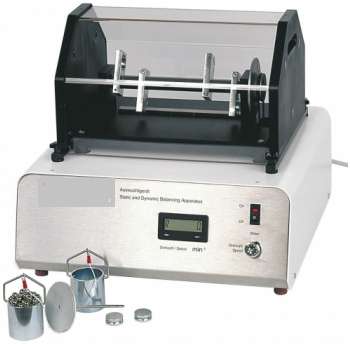EM-302.01 | Reciprocating and Rotating Balancing Machine
- Length: 420 mm.
- Width: 400 mm.
- Height: 380 mm.
- Weight: 26 kg.
Description
Technical Specification
Media
Imbalances on rotating machines are often the cause of disruptive vibrations and noise. During imbalance, the principal axis of inertia or center of gravity of the rotating machine component is outside its axis of rotation. By adding or removing masses, the center of gravity or the principal axis of inertia can be shifted so that both coincide with the axis of rotation. This process is called balancing. The machine component is then balanced and runs without vibration.
The experimental unit can be used to demonstrate imbalance and the balancing process clearly. The difference between a static and a dynamic imbalance can be shown. Imbalance is determined and balanced by appropriate measures.
The main element of the experimental unit is a smooth shaft to which four variable imbalance masses are attached at any angular and longitudinal position. The shaft is mounted on ball bearings. It is driven by a variable-speed electric motor and a belt. The speed of the shaft is displayed digitally.
In order to determine the imbalance, a defined external moment is applied via an additional pulley with weights. This moment is compared to the moment of the imbalance masses. A transparent cover protects against contact with rotating parts and allows a clear view of the shaft. Unwanted vibrations are suppressed by using an elastic bearing for the foundation.
Experimental Capabilities
- Demonstration of imbalance vibrations at different speeds.
- Comparison of static, dynamic or general imbalance.
- Determine an imbalance.
- Perform a balancing operation.
Labeled Diagram
The labeled diagram of apparatus is given bellows such as:- Variable weight.
- Imbalance masses.
- Angular scale.
- Drive belt.
- Foundation with elastic bearing.
- Static imbalance.
- Dynamic imbalance; S center of gravity; blue: mass distribution, red: principal axis of inertia.
Scope of Delivery
- 1 experimental unit.
- 1 set of tools.
- 1 set of weights.
- 1 set of instructional material.
- Demonstration of static and dynamic imbalance.
- Determine imbalance.
- Processes involved in balancing.
- Transparent protective cover for safe operation.
- Foundation with elastic bearing.
- Integrated angular and longitudinal scale.
- Digital speed display.
- Number of imbalance masses: 4.
- Total imbalance: 880cmg.
- Measuring ranges:
- Speed: 0…1400min-1
Any questions? We are happy to help...
+49 40 670 854 - 0
sales@gunt.de
Newsletter
About Us
EduTech Lahore excels in designing and supplying cutting-edge equipment for Engineering Education in Mechanical,Polymer
Chemical, Civil and Control Engineering. Focused on meeting the demand for quality education, we offer cost-effective solutions for the latest teaching equipment.
Contact Info
- EduTech Lahore, 2nd Floor, Plaza No.1009, Block-F, Commercial Area, State Life Insurance Employees Cooperative Housing Society Limited, Lahore.
- +92 321 88 35034
- (042) 35460635
- info@edutechlahore.com

